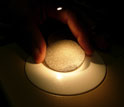News Release 09-229
Science Journalism Awards Announced
Winners of AAAS Kavli Awards include television and radio stories supported by NSF

Neil deGrasse Tyson examines an unpolished man-made diamond, fresh out of the grower.
November 19, 2009
This material is available primarily for archival purposes. Telephone numbers or other contact information may be out of date; please see current contact information at media contacts.
A television feature about growing diamonds in the lab, and a radio story that dramatizes some strange coincidences in a discussion of randomness and probability won recognition earlier this month in the 2009 AAAS Kavli Science Journalism Awards. So did a story for children about research about underground lakes in Antarctica. All three of these productions were funded in part by the National Science Foundation.
"Diamond Factory" was produced by Julia Cort for WGBH's NOVA science NOW, and aired on public television stations in June. It features host Neil deGrasse Tyson showing how materials science offers the means to engineer diamonds with the strength and conductivity of the real thing. Along the way, Tyson variously adopts the persona of Indiana Jones and travels blindfolded to the diamond producers' top-secret location, where he learns that diamonds that can be customized in size and shape offer a valuable resource for future electronics, transportation and communications.
"Julia Cort is a master of expressing complicated ideas in a way that's easy to understand and compelling in following the story," said Paula Apsell, senior executive producer, NOVA, and director of the WGBH science unit. "The techniques she used are emblematic of the approach we take at NOVA scienceNOW, creating stories that are educational and entertaining and, critically, that appeal to families."
"A Very Lucky Wind" was produced by Jad Abumrad, Soren Wheeler and Robert Krulwich at WNYC's Radio Lab and also aired in June. It begins with the story of a girl in England, Laura Buxton, who sends a balloon into the air--but not before attaching a label that said, "Please send back to Laura Buxton." The balloon winds up touching down 140 miles away in the yard of a girl with the same name, of the same age, and sharing many other traits. The producers use this as a departure point for a spirited discussion of randomness versus fate, incorporating the perspectives of University of California, Berkeley statistician Deborah Nolan and Jay Koehler, professor at the McCombs School of Business at the University of Texas at Austin.
Jad Abumrad said the show was inspired by questions about the true state of randomness.
"What is a miracle? What is the mathematical threshold for a miracle?" said Abumrad. "These were among our questions. And we learned that given enough time, strange things will happen."
"Where rivers run uphill" is a science story for children that was posted to the Science News for Kids Web site last year. Writer Douglas Fox accompanied glaciologist Slawek Tulaczyk on a trip to Antarctica, taking on the task of making Tulaczyk's research about subglacial lakes and rivers understandable to children. In his story, he brings alive not only the strange properties of a continent where rivers can run uphill and glaciers evaporate, but also the careful scientific work involved in measuring the rising and falling of the West Antarctic Ice Sheet to start to understand how water controls the ice's slide toward the ocean.
"Kids are bombarded by so much empty rhetoric," said Fox. "I think it's important for them to learn about how research on climate and glaciers is actually done, and how answers to important question are actually obtained. Only then can they really think for themselves."
The 2009 awards are the first to be given under a new endowment by The Kavli Foundation. In recognition of that endowment, the awards--first given in 1945--are now called the AAAS Kavli Science Journalism Awards. The Foundation, based in Oxnard, California, is dedicated to advancing science for the benefit of humanity.
Independent panels of science journalists select the winners of the awards. The winners for each category will receive $3000 and a plaque at the 2010 AAAS Annual Meeting in San Diego in February.
-NSF-
-
A polycrystalline diamond disc, made with chemical vapor deposition, is shown.
Credit and Larger Version -
Slawek Tulaczyk installs precision GPS sensor for monitoring subglacial lake.
Credit and Larger Version
Media Contacts
Maria C. Zacharias, NSF, (703) 292-8454, email: mzachari@nsf.gov
The U.S. National Science Foundation propels the nation forward by advancing fundamental research in all fields of science and engineering. NSF supports research and people by providing facilities, instruments and funding to support their ingenuity and sustain the U.S. as a global leader in research and innovation. With a fiscal year 2023 budget of $9.5 billion, NSF funds reach all 50 states through grants to nearly 2,000 colleges, universities and institutions. Each year, NSF receives more than 40,000 competitive proposals and makes about 11,000 new awards. Those awards include support for cooperative research with industry, Arctic and Antarctic research and operations, and U.S. participation in international scientific efforts.
Connect with us online
NSF website: nsf.gov
NSF News: nsf.gov/news
For News Media: nsf.gov/news/newsroom
Statistics: nsf.gov/statistics/
Awards database: nsf.gov/awardsearch/
Follow us on social
Twitter: twitter.com/NSF
Facebook: facebook.com/US.NSF
Instagram: instagram.com/nsfgov




